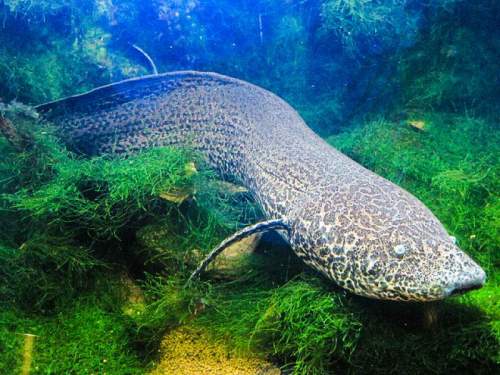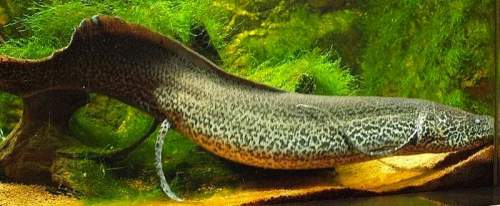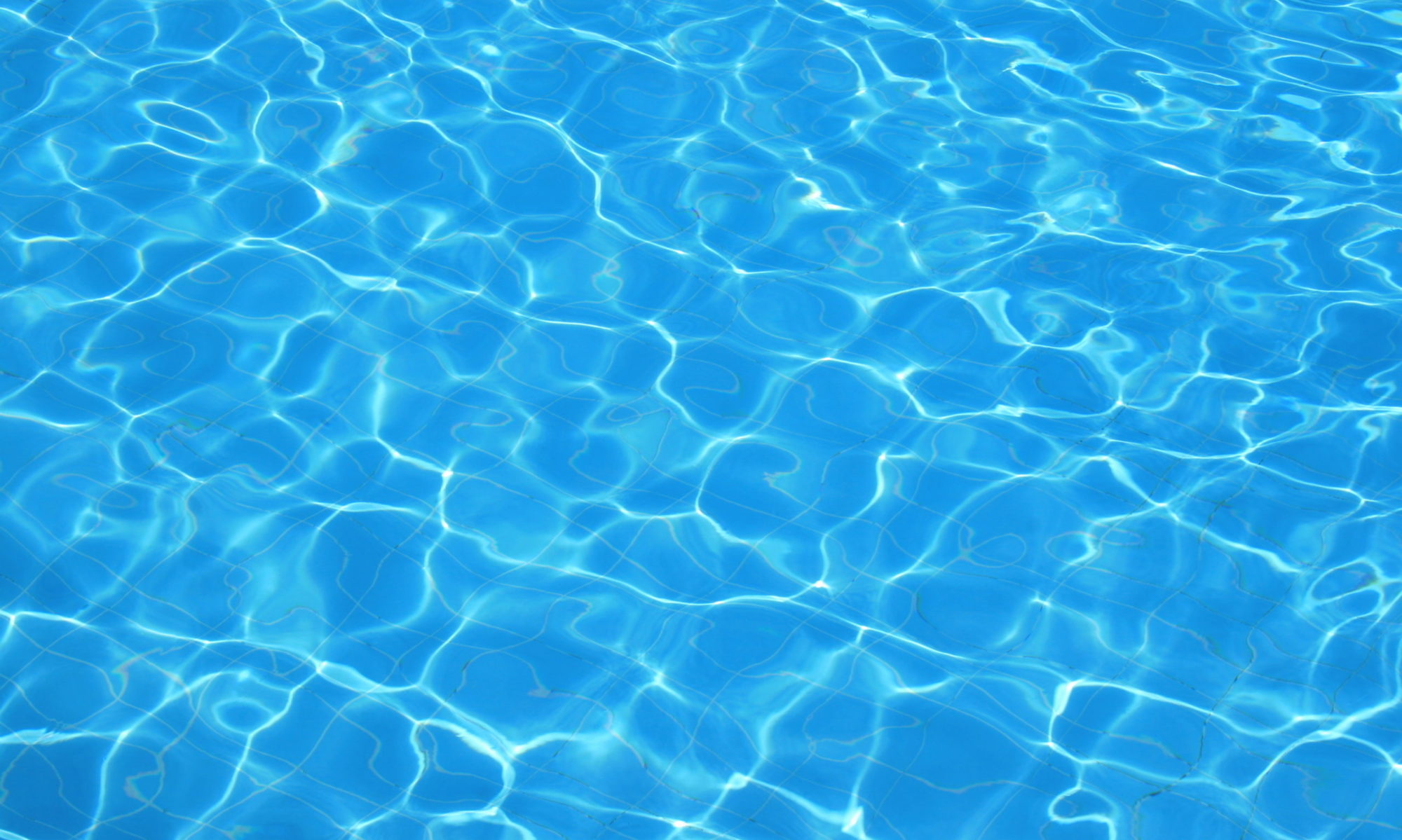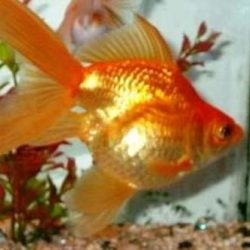Ornamental fish > South American lungfish – Lepidosiren paradoxa > Marbled lungfish – Protopterus aethiopicus
The marbled lungfish (Protopterus aethiopicus) belongs to the Family Protopteridae (African lungfishes) in class Sarcopterygii (fleshy-finned fishes). These fish are also known as leopard lungfish and African lungfish.
The marbled lungfish is native to the Nile, Congo, Lualaba, Malagarasi and Rusizi River basins and also lakes like Victoria, Tanganyika, Albert, Edward, Malebo Pool and Turkana.
The marbled lungfish has been successfully introduced into Lake Mohasi. These lungfish are native in the African countries like Burundi, Egypt, Kenya, Sudan, Uganda, Zambia, Tanzania, Ethiopia and Congo.
The marbled lungfish have developed functional lungs, which are the primary breathing organs. These fish are obligate air-breathers under experimental conditions, but in certain wild conditions they thrive without aerial respiration.
Aestivation is another characteristic evolved by the marbled lungfish to withstand desiccation during long dry spells. The hatchlings and young fish have true external gills and tadpole-like appearance. Till they develop lungs, they are completely dependent on the gills for respiration.
Description of marbled lungfish
The marbled lungfish has smooth, slimy, elongated, cylindrical, eel-like body tapering into pointed tail. The scales are deeply embedded. Dorsally the lungfish is dark, slaty-gray and ventrally bright yellow, grayish-yellow or pinkish, depending upon the specimen and subspecies.

There are darker gray patches all over the body; hence the name leopard lungfish. The sensory canals can been seen outlined black. Albino marbled lungfish is a rarity, which has a creamy body with a few slightly darker patches.
The head has a conical profile with the mouth at the anterior end. Eyes are very small and it is believed that the marbled lungfish tracks its food more by smell-sense.

Its premaxillary and maxillary bones are fused as in all lungfish to form heavily mineralized tooth-plates. The swim bladder has evolved into functional lungs and the gills have reduced function.
The pectoral and pelvic fins are long, thin and fleshy and similar to scaly salamander-fish. The pelvic fins are larger and set far behind and somewhat function like walking/crawling legs.
The dorsal fin originates on the middle of the back and merges with caudal fin. Similarly, the anal fin originating behind the anal opening merges with the caudal fin.
Other behaviors and adaptations
Apart from the ability to breathe air, they have undergone several physiological modifications. When the water sources dry up, they undergo aestivation, a state of animal dormancy, characterized by inactivity and a lowered metabolic rate. The marbled lungfish burrow 12 to 20 inches into mud and make a chamber of mucus-mud.
They leave a few holes on the surface for air. They can survive in such state, even for two or three years. The juveniles are tadpole-like and have four external gills. They entirely depend on these gills for respiration, till they develop lungs.
Habitat and ecosystem
The marbled lungfish inhabit river and lake fringes, swamps, floodplains, pools, creeks and tributaries with stagnant or slow flowing waters. Such water bodies have very low dissolved oxygen and are likely to dry up in dry season.
The ability to directly breathe air and the capacity for aestivation are the adaptation evolved by them for their survival in such conditions.
Distribution
The marbled lungfish are widely distributed in Africa, and are found throughout Nile, Congo, Lualaba, Malagarasi and Rusizi River basins and also in lakes like Victoria, Tanganyika, Albert, Edward, Malebo Pool and Turkana.
Reproduction and development
With the onset of rainy season and flooding, the mature fish breed. The male fish digs and cleans a burrow and one or several females spawn in the pit nest. The female marbled lungfish leaves the pit after releasing the eggs.
The male guards the eggs and young for nearly eight weeks. Apart from protecting the young, the male constantly aerates the water in the nest. The hatchlings have thread-like external gills and resemble tadpoles. At this stage they can survive only with the dissolved oxygen in the water.
The male marbled lungfish constantly aerates the water in the nest hole. After 2-3 months, the external gills are resorbed leaving a hole in the gill chamber and the young marble lungfish develop lungs for air breathing.
Life cycle
The maximum recorded length of a wild specimen is 6 feet (200 cm), which is estimated to weigh 17 kg. These fish may live up to 20 years in captivity.
Diet and feeding habits
Juvenile fish feed on insects and their larvae and small animals. The adult marble fish is omnivorous feeding on fish, mollusks, shrimps, detritus and algal matter.
Conservation status
IUCN Red List status is Not Evaluated for marbled lungfish.
Marbled lungfish aquarium
To accommodate such long-living, marbled lungfish we may require an aquarium of at least 100 gallon capacity. Future capacity to go in for bigger tank is the main criterion for embarking on setting up an aquarium for these fish.
The tank must have lot of space for movement and also have some hiding spots. With the amount of organic and metabolic wastes being generated, a massive filtering system may be necessary. Please visit pages on quick facts and Protopterus aethiopicus aquarium for further information.
Reference: https://www.fishbase.org/summary/8734
1.Image source: https://www.flickr.com/photos/40295335@N00/4840412198
Image author: Joel Abroad | License: CC BY 2.0 (as on 2016-10-18)edited
2.Image source: https://commons.wikimedia.org/wiki/File:Marbled_lungfish_2.jpg
Image author: OpenCage | License: CC BY 2.5 (as on 2016-10-18)edited
Current topic in Aquarium fish pictures: Marbled lungfish – Protopterus aethiopicus

